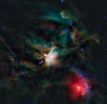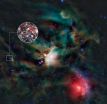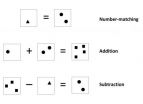(Press-News.org) Life is made up of a series of complex organic molecules, including sugars. A team of astronomers led by researchers from the Niels Bohr Institute, have now observed a simple sugar molecule in the gas surrounding a young star and this discovery proves that the building blocks of life were already present during planet formation. The results have been published in the scientific journal Astrophysical Journal Letters.
The star was observed with the new large international telescope, Atacama Large Millimeter Array (ALMA) in northern Chile. The ALMA telescopes are able to zoom in and study the details of newly formed stars and their rotating discs of dust and gas, which subsequently clumps together and forms planets. Among other things, the astronomers would like to investigate the gas for the presence of water vapour and examine the chemical composition for complex molecules.
Sugar around new stars
"In the protoplanetary disc of gas and dust surrounding the young, newly formed star, we found glycolaldehyde molecules, which are a simple form of sugar. It is one of the building blocks in the process that leads to the formation of RNA and the first step in the direction of biology," explains astrophysicist Jes Jørgensen, Associate Professor at the Niels Bohr Institute and the Centre for Star and Planet Formation at the University of Copenhagen.
He explains that at first the gas and dust cloud is extremely cold (only around 10 degrees above absolute zero at minus 273 degrees C) and simple gases such as carbon monoxide and methane settle on particles of dust and solidify as ice. Here on the particles of dust, the otherwise volatile gases come close to each other and can bond together and form more complex molecules. When the star has been formed in the middle of the gas and dust cloud, it emits heat, and the inner parts of the rotating cloud surrounding the star is heated to around room temperature, after which the chemically complex molecules on the particles of dust evaporate as gas. This gas emits radiation as radio waves at low frequencies and it is this radiation that researchers can observe with the ALMA telescopes.
Precursors for biology before planets
The star is located only 400 light years from us – so, seen in an astronomical context, it is right in our own neighbourhood. With the very high resolution of the new telescopes, researchers now have the opportunity to study the details of the dust and gas clouds, and in addition to the sugar molecules the researchers also saw signs of a number of other complex organic molecules, including ethylene-glycol, methyl-formate and ethanol.
"The complex molecules in the cloud surrounding the newly formed star tell us that the building blocks of life may be among the first formed. One of the big questions is whether it is common that these organic molecules are formed so early in the star and planet formation process – and how complex they can become before they are incorporated into new planets. This could potentially tell us something about the possibility that life might arise elsewhere and whether precursors to biology are already present before the planets have been formed," explains Jes Jørgensen.
INFORMATION:
Niels Bohr Institute: http://www.nbi.ku.dk/english/
For more information:
Jes K. Jørgensen, astrophysicist, PhD, Associate Professor,
Niels Bohr Institute, Centre for Star and Planet Formation, University of Copenhagen
+45 3532-0569 or +45 3532-4186 or +45 4250-9970 (mobile) jeskj@nbi.dk
www.nbi.dk/~jeskj http://youngstars.nbi.dk/jeskj
Sweet building blocks of life found around young star
2012-08-29
ELSE PRESS RELEASES FROM THIS DATE:
Sweet result from ALMA
2012-08-29
A team of astronomers using the Atacama Large Millimeter/submillimeter Array (ALMA) has spotted sugar molecules in the gas surrounding a young Sun-like star. This is the first time sugar been found in space around such a star, and the discovery shows that the building blocks of life are in the right place, at the right time, to be included in planets forming around the star.
The astronomers found molecules of glycolaldehyde -- a simple form of sugar [1] -- in the gas surrounding a young binary star, with similar mass to the Sun, called IRAS 16293-2422. Glycolaldehyde ...
Adelaide joins with Italy to develop 'super spaghetti'
2012-08-29
University of Adelaide researchers are working with colleagues in Italy to produce better quality pasta that also adds greater value to human health.
Two research projects - being conducted by the ARC Centre of Excellence in Plant Cell Walls at the University's Waite Campus - will start next month in collaboration with researchers from the Italian universities of Bari and Molise.
The aim of the ARC Centre of Excellence is to look at the fundamental role of cell walls (biomass) in plants and discover how they can be better utilized. Both of these new projects will investigate ...
Math ability requires crosstalk in the brain
2012-08-29
A new study by researchers at UT Dallas' Center for Vital Longevity, Duke University, and the University of Michigan has found that the strength of communication between the left and right hemispheres of the brain predicts performance on basic arithmetic problems. The findings shed light on the neural basis of human math abilities and suggest a possible route to aiding those who suffer from dyscalculia-- an inability to understand and manipulate numbers.
It has been known for some time that the parietal cortex, the top/middle region of the brain, plays a central role ...
New 'traffic light' test could save lives with earlier diagnosis of liver disease
2012-08-29
A new 'traffic light' test devised by Dr Nick Sheron and colleagues at University of Southampton and Southampton General Hospital could be used in primary care to diagnose liver fibrosis and cirrhosis in high risk populations more easily than at present.
Liver disease develops silently without symptoms, and many people have no idea they have liver failure until it is too late – one-third of people admitted to hospital with end-stage liver disease die within the first few months. A simple test available in primary care could diagnose disease much earlier, enabling those ...
Internet addiction -- Causes at the molecular level
2012-08-29
"It was shown that Internet addiction is not a figment of our imagination," says the lead author, Privatdozent Dr. Christian Montag from the Department for Differential and Biological Psychology at the University of Bonn. "Researchers and therapists are increasingly closing in on it." Over the past years, the Bonn researchers have interviewed a total of 843 people about their Internet habits. An analysis of the questionnaires shows that 132 men and women in this group exhibit problematic behavior in how they handle the online medium; all their thoughts revolve around the ...
Twitter data crunching: The new crystal ball
2012-08-29
Fabio Ciulla from Northeastern University, Boston, USA, and his colleagues demonstrated that the elimination of contestants in TV talent shows based on public voting, such as American Idol, can be anticipated. They unveiled the predictive power of microblogging Twitter signals--used as a proxy for the general preference of an audience--in a study recently published in EPJ Data Science¹.
The authors considered the voting system of these shows as a basic test to assess the predictive power of Twitter signals. They relied on the overlap between Twitter users and show audience ...
Earphones 'potentially as dangerous as noise from jet engines,' according to new study
2012-08-29
Turning the volume up too high on your headphones can damage the coating of nerve cells, leading to temporary deafness; scientists from the University of Leicester have shown for the first time.
Earphones or headphones on personal music players can reach noise levels similar to those of jet engines, the researchers said.
Noises louder than 110 decibels are known to cause hearing problems such as temporary deafness and tinnitus (ringing in the ears), but the University of Leicester study is the first time the underlying cell damage has been observed.
The study has ...
New research eclipses existing theories on moon formation
2012-08-29
Oxford, August 29, 2012 - The Moon is believed to have formed from a collision, 4.5 billion years ago, between Earth and an impactor the size of Mars, known as "Theia." Over the past decades scientists have simulated this process and reproduced many of the properties of the Earth-Moon system; however, these simulations have also given rise to a problem known as the Lunar Paradox: the Moon appears to be made up of material that would not be expected if the current collision theory is correct. A recent study published in Icarus proposes a new perspective on the theory in ...
Don't cut lifesaving ICDs during financial crisis, ESC warns
2012-08-29
Implantable devices for treating cardiac arrhythmias, which include ICDs, are already underused in parts of Eastern and Central Europe and there is a risk that the financial crisis could exacerbate the problem. The European Heart Rhythm Association (EHRA), a registered branch of the ESC, is tackling this issue through ICD for Life. The initiative aims to raise awareness about the importance of ICDs and sudden cardiac death in countries in Central and Eastern Europe.
ICD implantation rates in Europe vary widely, ranging from 1 ICD implantation per million inhabitants in ...
Gold standards of success defined for AF ablation
2012-08-29
The 2012 expert consensus statement on catheter and surgical ablation of atrial fibrillation was developed by the Heart Rhythm Society (HRS), the European Heart Rhythm Association (EHRA), a registered branch of the European Society of Cardiology (ESC), and the European Cardiac Arrhythmia Society (ECAS) and published in their respective journals: Heart Rhythm, EP Europace (1) and the Journal of Interventional Cardiovascular Electrophysiology (JICE).
Since the previous consensus document was published in 2007 catheter and surgical ablation of AF have become standard treatments ...



